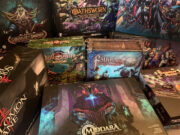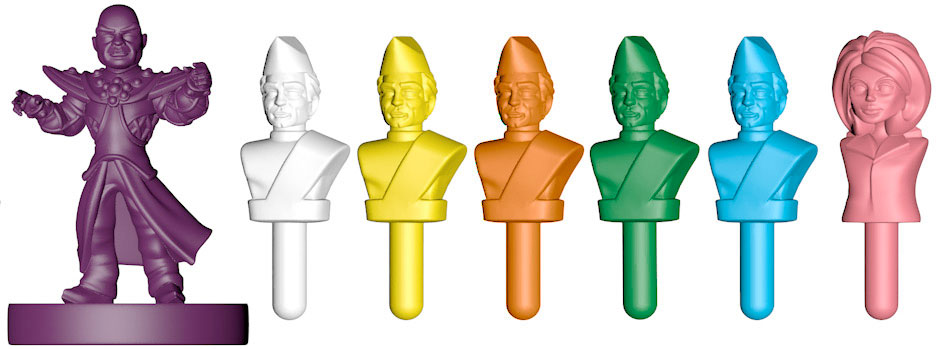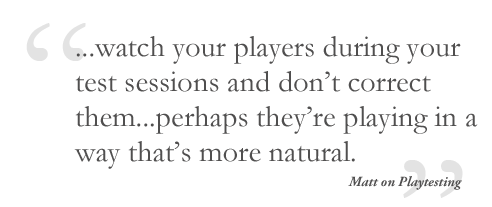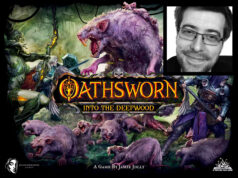 Recently we had a chance to talk a little with veteran game designer Matt Leacock. You may have heard of a few of his titles: Pandemic, Roll Through the Ages and Forbidden Island. It’s no great leap to say that Matt is quite the accomplished game designer.
Recently we had a chance to talk a little with veteran game designer Matt Leacock. You may have heard of a few of his titles: Pandemic, Roll Through the Ages and Forbidden Island. It’s no great leap to say that Matt is quite the accomplished game designer.
With his newest title, Thunderbirds, now in funding on Kickstarter, we figured it’d be a good time to pick his brain about some of his past accomplishments and also his newest offering.
Board Game Quest: Let’s start with the obvious question. Walk us through your design process. How do you go about it from the early stages to the final product?
Matt: I’ll try to summarize as best I can; that’s a pretty broad question! I start with a creative brief. I try to work out whom I’m designing for and what the overall objective of the design is. After I have a brief, I start sketching, prototyping, and experimenting in an attempt to find the core ideas behind the game. Sometimes these two steps are reversed—I’ll stumble upon an idea or get an itch to explore something and then write up some goals to refine it further.
Once I have a core concept and a goal, I move on to a process of further prototyping, testing, and iteration. I spend about half my time here, finding the boundaries of the design. Here, I try to explore many options and go wide until I feel like I understand the design space and haven’t left any great opportunities for the design off the table.
After I have a complete prototype and full set of rules that I can play end-to-end, I move into refinement. Here, I continue testing the game with a circle of people that gradually widens. I first test with colleagues, then friends and family, then friends of friends, and then people I don’t know. As the circle widens, the fidelity of the prototype goes up and the type of feedback I’m looking for changes. Early on, I’m looking for feedback on larger, structural elements. Later on, I’m focused on nuance—the terms people use, the visual language in the game, the way the play aides are presented, and the way the rules are written.
I’m often working with the publisher near the end of this phase, offering input on the visual design and other aspects of the production. And once this has been wrapped up, I’m usually off to another project.
 BGQ: Pandemic is undoubtedly a hit game, having sold about a bajillion copies or so. What’s it like to have designed a game beloved by so many?
BGQ: Pandemic is undoubtedly a hit game, having sold about a bajillion copies or so. What’s it like to have designed a game beloved by so many?
Matt: Unreal. I had no absolutely no idea that the game would be this successful. More than anything, I’ve enjoyed meeting fans of the game around the world and hearing their stories of how the game brought them into the hobby—or brought them closer to members of their family.
BGQ: On the same track, how difficult is it to design a game after you have a hit like Pandemic? I’m sure expectation can be set quite high. Do you feel pressure to strike gold again?
Matt: I’ve been extremely lucky—the first three games I designed (Pandemic, Roll Through the Ages: The Bronze Age, and Forbidden Island) were all nominated for the Spiel des Jahres in Germany, so I don’t worry so much about being a “one-hit-wonder.” That said, I’d rather design a smaller number of really high quality games than go for quantity. My strategy has been to only sign up for projects that I’m really passionate about and I count myself lucky that I’m able to pick-and-choose the projects that I work on.
BGQ: You’ve designed a number of games since your first one, has your process changed at all since you first started?
Matt: Yes, I’ve learned how to be more focused when it comes to my goals for a particular design. Some of my earlier (unpublished) work meandered over dozens and dozens of iterations. Now I spend more time upfront defining what success will look like. I’ve also brought more rigor to the way I playtest games. In the later stages of design I now ask blind testers to video record their sessions and I spend a lot of time recording insights and iterating designs based on the findings.
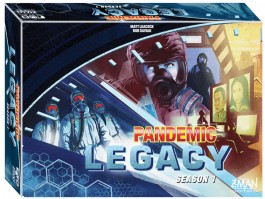 BGQ: One of the most anticipated games of the year has to be Pandemic: Legacy. How far along is it and what can you tell us about it? Maybe a secret that no one knows yet? 🙂
BGQ: One of the most anticipated games of the year has to be Pandemic: Legacy. How far along is it and what can you tell us about it? Maybe a secret that no one knows yet? 🙂
Matt: I’m happy to report that Rob Daviau and I wrapped on the design last week and Z-man is now busy with production. The game is set to premiere at Spiel this October.
Pandemic Legacy unfolds over the course of a terrible year. The first game will be familiar to people who have played Pandemic, but as the game progresses, it will evolve. The actions you take in each game will carry over into future games. Cities will degrade. Your characters will change… It’ll be up to you and your team to see if you can survive the year and save humanity.
BGQ: Are the core mechanics relatively unchanged from Pandemic to Pandemic Legacy or will this be a whole new experience?
Matt: You’ll be able to get up and running very quickly for game one. As you play, the game will evolve under you as events take place and as a consequence of the decisions you make. That’s one of the strengths of the format: the game gradually introduces new concepts so you can get rolling quickly.
BGQ: I’m sure designing a Legacy game must have been a new experience for you. How hard was it creating a legacy game vs a normal game?
Matt: Pandemic: Legacy was a marathon. Each boxed set unfolds 12 to 24 full length, end-to-end games that build on each other, one after another. In a sense it was like designing 12 games. Putting the design aside, consider the testing: It’s no small thing to ask multiple groups of people to dedicate 12 to 24 hours to playing the game, have them video-record their sessions, and then watch them all as you record observations. Then, add to that the complexity of the product design for all of the hidden bits and surprises. The experience was really rewarding and Rob was an excellent partner. That said, the design was much more involved and difficult than any of my previous games.
 BGQ: Moving on to your current project, Thunderbirds is currently in funding on Kickstarter. For those that don’t know, Thunderbirds was a TV show from the 60s. Was it hard to develop a game based off an existing license vs one of your own creation?
BGQ: Moving on to your current project, Thunderbirds is currently in funding on Kickstarter. For those that don’t know, Thunderbirds was a TV show from the 60s. Was it hard to develop a game based off an existing license vs one of your own creation?
Matt: The central engine of the game (completing missions around the world) came fairly easily and naturally, while The Hood’s scheme mechanism gradually unfolded as a way to provide a narrative structure and an overall objective to the game. I really enjoyed designing to the world of International Rescue. I think things came naturally as the theme and story behind the show was such a natural fit for a cooperative game.
BGQ: Were you a fan of the TV show Thunderbirds? How much research did you do before designing the game?
Matt: I had never heard of Thunderbirds. When Chris Birch approached me at Spiel about possibly designing the game, he had so much excitement and enthusiasm behind his eyes that I told him I’d check it out. I loved the show, thought it was a good fit, and signed up. After that, I watched all the episodes and movies, read many of the comics, and have two very well-worn sourcebooks. I poured over the material to the point that I was able to write the synopses for each of the mission cards in the game.
BGQ: It sounds like you had fun working on Thunderbirds. Is there a particular licensed property out there that you’d really like to build a game around?
Matt: Not right now, no. I’ve been keeping my eyes open though. I enjoyed this project quite a bit and would be open to doing other licenses.
BGQ: What one thing you want everyone to know about the Thunderbirds game?
Matt: Thunderbirds is a fantastic cross-over game that should appeal to both casual players and gamers alike. It’s also a great cross-generational game; it’ll provide a great way for parents to share the world of International Rescue with their kids.
 BGQ: I think that Thunderbirds can really appeal to a broad base. Like almost all your titles, Thunderbirds is a cooperative game. Why do you seem to be drawn to this genre?
BGQ: I think that Thunderbirds can really appeal to a broad base. Like almost all your titles, Thunderbirds is a cooperative game. Why do you seem to be drawn to this genre?
Matt: I love designing games that I can pull out to play with friends and family. I have such good responses with the cooperative games since they don’t generate the feelings of resentment or bitterness that sometimes accompany competitive games. Even when you lose, you lose together. I also enjoy creating the underlying systems that power the games. I find it a fun challenge to tell a compelling story and create an “intelligent opponent” using only paper and cardboard.
BGQ: At the same time, what do you think about the “quarterbacking” issue (where one player takes the lead and directs other players at the table) that’s prevalent in so many cooperative games, including Pandemic?
Matt: Sure, it’s no fun to play when you’re playing with an overbearing teammate. That’s as true in games as it is in real life. While I’m always on the lookout for new mechanisms I can add to my games to mitigate this type of behavior, you can always play different games with these people, or choose different people to play with when you break out a cooperative game.
BGQ: Is there a game out there that you really wished you designed but didn’t?
Matt: I’m fascinated by deck building games. I would have like to have tried my hand at one of those when the form was just emerging.
BGQ: I’m sure many game designers would love to have the success you’ve had in your career. Do you have any advice for aspiring designers out there?
Matt: One piece of advice: watch your players during your test sessions and don’t correct them. Examine carefully what mistakes they’re making—perhaps they’re playing in a way that’s more natural. Listen to the words they’re using to describe the actions they’re taking and the objects they’re interacting with. Do they match the terms you’ve chosen? If not, perhaps you should change your terms to match theirs. And listen to yourself. If you ever find yourself wanting to apologize for some aspect of your design, take note of it! See if there’s a way you can remove it.
BGQ: Finally, a fun question: If you could play one game with any person (or people), living or dead, which game would it be and who would you play it with?
Matt: I’d love to get a game of Knizia’s Modern Art in with Steve Martin, Paul Simon, and Rene and Georgette Magritte. (They could bring their dog too.)
That’s about all the time we had to bug Matt. I really appreciate him taking the time to answers some of our questions. If you are a fan of some of his past games, then make sure you check out Thunderbirds on Kickstarter. You can pick up a copy of Thunderbirds for £40 for the Core Game. The campaign ends on Sunday, March 29th and is expected to be in backers hands in August this year. Head over today and give it a look.




